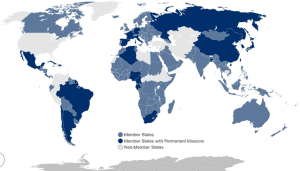TAG: GS 2: INTERNATIONAL RELATIONS, GS 1: GEOGRAPHY
THE CONTEXT: India is set to apply for licenses to explore deep-sea minerals in the Pacific Ocean, aiming to secure vital resources for energy transition technologies.
EXPLANATION:
- The International Seabed Authority (ISA), backed by the UN, has already issued 31 deep-sea exploration licenses, including two for India in the Indian Ocean.
- However, the ISA has not yet permitted mining as it is still finalizing regulations.
- The 36-member ISA council is meeting in Jamaica to negotiate the latest draft of the mining code.
India’s Strategy and Focus Areas
- The lead scientist at India’s Ministry of Earth Sciences stated that the ministry will collaborate with the mining industry to prepare for next year’s application for seabed mineral exploration in the Pacific.
- India plans to target the Clarion-Clipperton Zone, a vast area between Hawaii and Mexico, rich in polymetallic nodules containing essential minerals for electric vehicles and solar panels, including manganese, nickel, copper, and cobalt.
- The Clarion-Clipperton Zone is known for its polymetallic nodules, first discovered by British sailors in 1873.
- These potato-shaped nodules take millions of years to form and contain high concentrations of critical minerals.
India’s Preparedness and Technological Challenges
- Unlike China, India lacks expertise in seabed mining and will need at least three to four years to develop the capability to extract minerals from the ocean depths.
- Former chief of India’s Ministry of Earth Sciences acknowledged that while significant progress has been made in deep-sea mining technology, it is not yet perfected.
Environmental Concerns and Opposition
- Deep-sea mining faces significant opposition due to potential environmental impacts.
- An ocean governance specialist expressed doubts about current technologies’ ability to mitigate these environmental concerns.
- Some 27 countries have called for a moratorium on ocean mining-related activities, while nations like Nauru and the Cook Islands support it.
- Nauru plans to submit a mining license application to the ISA on behalf of Canada’s The Metals Company later this year.
Additional Exploration Permits for India
- India also anticipates receiving two more exploration permits from the ISA this year for regions in the Indian Ocean, specifically the Carlsberg Ridge and Afanasy-Nikitin Seamount.
- These areas are known for polymetallic sulphide deposits and ferromanganese crusts, containing metals like copper, gold, silver, zinc, cobalt, nickel, manganese, platinum, and rare earth elements.
- Each permit lasts for 15 years, as per the ISA.
India’s Critical Mineral Requirements
- India, heavily reliant on imports of raw materials such as copper and lithium, has identified 24 minerals as critical for its energy transition.
- The country is actively seeking overseas mineral assets to meet its growing green energy demands.
- The urgency of securing seabed minerals, describing the effort as a race against time has been emphasised.
International Seabed Authority (ISA):
- It is an intergovernmental body of 168 member states and the European Union.
- It was established under the 1982 UN Convention on the Law of the Sea (UNCLOS) and its 1994 Agreement on Implementation.
- The ISA’s dual mission is to authorize and control development of mineral related operations in the international seabed.
- The ISA is to safeguard the international deep sea, the waters below 200 meters or 656 feet, where photosynthesis is hampered by inadequate light Governing approximately half of the total area of the world’s oceans.
- The ISA exercise oversight of activities that might threaten biological diversity and harm the marine environment.
- The Authority operates as an autonomous international organization with its own Assembly, Council and Secretariat.
- India is a members of the International Seabed Authority (ISA).

Clarion-clipperton Zone:
- It is a region spanning 5,000 kilometers across the central Pacific Ocean, at depths of 4,000 – 5,500 meters.
- It is a vast area between Hawaii and Mexico, rich in polymetallic nodules.
- Polymetallic nodules are a potential mineral resource for copper, nickel, cobalt, iron, manganese, and rare earth elements.
- These minerals are essential for electric vehicles and solar panels, including manganese, nickel, copper, and cobalt.

